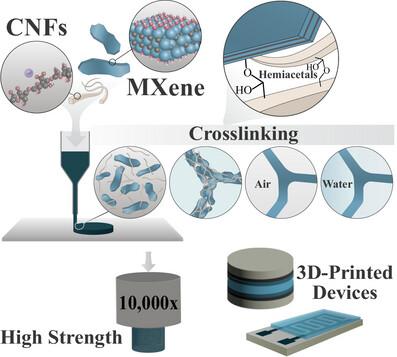3D打印交联纳米纤维素- MXene水凝胶和气凝胶具有高强度和导电性
IF 12.1
2区 材料科学
Q1 CHEMISTRY, MULTIDISCIPLINARY
引用次数: 0
摘要
基于挤压的3D打印是一种很有前途的制造方法,因为它可以集成各种纳米材料,包括高导电性的MXenes。然而,用MXene制造干湿稳定的3D打印结构仍然具有挑战性,因为很难形成具有所需流变性能的机械稳定交联网络。在这项工作中,开发了一种含有纤维素纳米纤维(CNFs)作为流变改性剂的MXene油墨配方,增强了结构完整性,并实现了一步冷冻诱导交联过程,从而产生了轻质多孔结构。3D打印结构具有卓越的机械强度,可支撑高达自身重量10,000倍的重量,同时保持超过195 S m−1的导电性。此外,它们在5 mV s−1下的特定电容为240 F g−1,突出了它们在先进离子电子器件中的应用潜力。一个完全3D打印的超级电容器概念以两种不同的配置展示:平面内和堆叠;证明了它们在水环境中的结构完整性和电化学稳定性。本文章由计算机程序翻译,如有差异,请以英文原文为准。

3D‐Printed Crosslinked Nanocellulose‐MXene Hydrogels and Aerogels with High Strength and Conductivity
Extrusion‐based 3D‐printing is a promising manufacturing method because it can integrate various nanomaterials, including highly conductive MXenes. Nevertheless, the fabrication of both wet and dry stable 3D‐printed structures with MXene has remained challenging due to the difficulty in forming mechanically stable, crosslinked networks with the required rheological properties. In this work, a MXene ink formulation incorporating cellulose nanofibers (CNFs) as rheology modifiers is developed, enhancing structural integrity and enabling a one‐step freeze‐induced crosslinking process to produce lightweight, porous structures. The 3D‐printed structures exhibit remarkable mechanical strength, supporting up to 10,000 times their own weight, while maintaining a conductivity of over 195 S m−1 . Additionally, they demonstrate a specific capacitance of 240 F g−1 at 5 mV s−1 , highlighting their potential for applications in advanced iontronic devices. A fully 3D‐printed supercapacitor concept is showcased in two distinct configurations: in‐plane and stacked; demonstrating their structural integrity and electrochemical stability in aqueous environments.
求助全文
通过发布文献求助,成功后即可免费获取论文全文。
去求助
来源期刊

Small
工程技术-材料科学:综合
CiteScore
17.70
自引率
3.80%
发文量
1830
审稿时长
2.1 months
期刊介绍:
Small serves as an exceptional platform for both experimental and theoretical studies in fundamental and applied interdisciplinary research at the nano- and microscale. The journal offers a compelling mix of peer-reviewed Research Articles, Reviews, Perspectives, and Comments.
With a remarkable 2022 Journal Impact Factor of 13.3 (Journal Citation Reports from Clarivate Analytics, 2023), Small remains among the top multidisciplinary journals, covering a wide range of topics at the interface of materials science, chemistry, physics, engineering, medicine, and biology.
Small's readership includes biochemists, biologists, biomedical scientists, chemists, engineers, information technologists, materials scientists, physicists, and theoreticians alike.
 求助内容:
求助内容: 应助结果提醒方式:
应助结果提醒方式:


